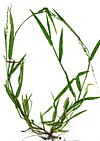Subfamily of plants
Anomochlooideae is a subfamily of the true grass family Poaceae . It is sister to all the other grasses. It includes perennial herbs that grow on the shaded floor of forests in the Neotropics . There are two genera, Anomochloa Streptochaeta ,
Description
Anomochlooideae are terrestrial,[ 3] [ 4]
Cytology
The diploid chromosome count of Anomochloa is 2n = 36, and the chromosome count of Streptochaeta is 2n = 22.[ 4]
Taxonomy
It was validly published in 1957 by Eva Hedwig Ingeborg Potztal based on previous work from Robert Knud Friedrich Pilger .[ 5] Anomochloa Brongn. [ 1] [ 5]
Evolutionary relationships
This subfamily is the most early-diverging lineage of the grasses:[ 6]
Conservation
Anomochloa marantoidea is almost extinct in the wild.[ 4]
References
^ a b Missouri Botanical Garden. (n.d.-d). Anomochlooideae Pilg. ex Potztal. Tropicos. Retrieved January 3, 2025, from https://www.tropicos.org/name/50063069
^ Soreng, Robert J.; Peterson, Paul M.; Romaschenko, Konstantin; Davidse, Gerrit; Zuloaga, Fernando O.; Judziewicz, Emmet J.; Filgueiras, Tarciso S.; Davis, Jerrold I.; Morrone, Osvaldo (2015). "A worldwide phylogenetic classification of the Poaceae (Gramineae)". Journal of Systematics and Evolution . 53 (2): 117– 137. doi :10.1111/jse.12150 . hdl :11336/25248 ISSN 1674-4918 . S2CID 84052108 . ^ Anomochlooideae in Flora e Funga do Brasil. Jardim Botânico do Rio de Janeiro. Available at: https://floradobrasil.jbrj.gov.br/FB102235 Accessed on: 04 Jan. 2025
^ a b c Kellogg, E.A. (2015). I. Subfamily Anomochlooideae Pilg. ex Potztal (1957). In: Flowering Plants. Monocots. The Families and Genera of Vascular Plants, vol 13. Springer, Cham.
^ a b subfam. Anomochlooideae Pilg. ex Potztal. (n.d.). International Plant Names Index. Retrieved January 4, 2025, from https://www.ipni.org/n/321655-2
^ Grass Phylogeny Working Group II (2012). "New grass phylogeny resolves deep evolutionary relationships and discovers C4 origins". New Phytologist . 193 (2): 304– 312. doi :10.1111/j.1469-8137.2011.03972.x . hdl :2262/73271 PMID 22115274 .
Morphology Ecology Subfamilies
Uses
Food Construction Landscaping Other

